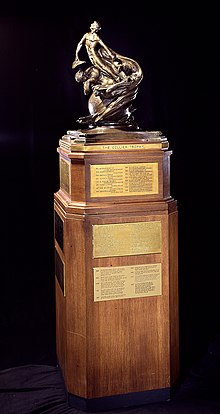| Robert J. Collier Trophy | |
|---|---|
 | |
| Awarded for | "the greatest achievement in aeronautics or astronautics in America, with respect to improving the performance, efficiency, and safety of air or space vehicles, the value of which has been thoroughly demonstrated by actual use during the preceding year."[1] |
| Country | United States |
| Presented by | National Aeronautic Association (NAA) |
| First awarded | 1911 |
| Website | https://naa.aero/awards/awards-trophies/collier-trophy/ |

The Robert J. Collier Trophy is awarded annually for the greatest achievement in aeronautics or astronautics in America, with respect to improving the performance, efficiency, and safety of air or space vehicles, the value of which has been thoroughly demonstrated by actual use during the preceding year.
The Collier Trophy is administered by the National Aeronautic Association (NAA) the oldest national aviation organization in the United States. Founded in 1905, the NAA oversees America's oldest and most prestigious aviation and aerospace recognitions. The Collier Trophy is the most coveted of all.
Robert J. Collier, publisher of Collier's Weekly magazine, was an air sports pioneer and president of the Aero Club of America.[1] In 1910, he commissioned Baltimore sculptor Ernest Wise Keyser to make the 525-pound (238 kg) Aero Club of America Trophy.[1][2] First awarded in 1911 to Glenn H. Curtiss for his successful development of the hydro-aeroplane.[2] Collier presented his namesake trophy several times before his death in 1918.
The award is presented once a year by the NAA president, with the trophy on permanent display at the National Air and Space Museum.[1]
The trophy was stolen briefly in 1978, but was recovered.[3] The thieves left it at Fort Foote park and it was recovered 26 hours from the time it went missing.[4]
- ^ a b c d "Collier Trophy". NAA.aero. NAA. Retrieved July 23, 2020.
- ^ a b Cite error: The named reference
collier11was invoked but never defined (see the help page). - ^ "Collier Trophy Stolen from Mayflower".
- ^ "Stolen Collier Trophy Found in Park". The Ithaca Journal. Ithaca, New York. Associated Press. June 1, 1978. p. 30 – via Newspapers.com.